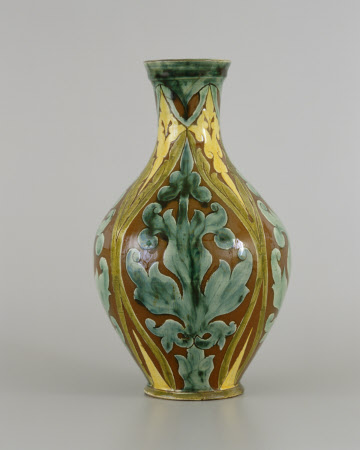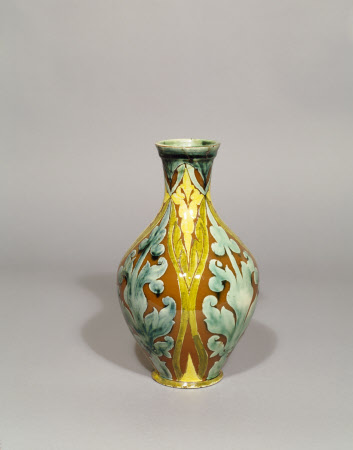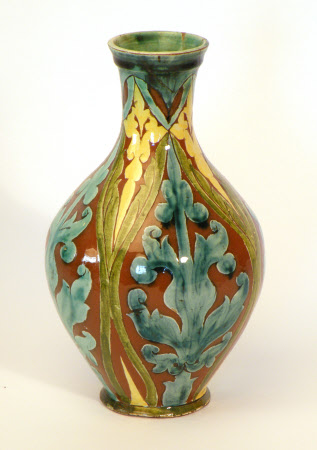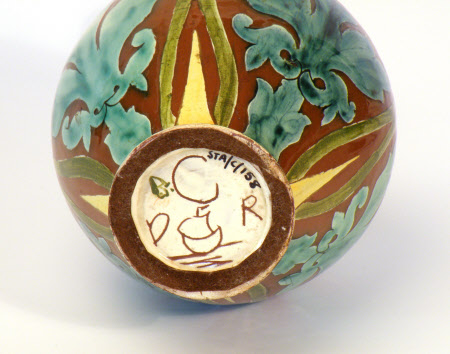Vase
Della Robbia Pottery
Category
Ceramics
Date
1894 - 1900
Materials
earthenware with sgraffito and coloured glazes
Measurements
245 mm (H)60 mm (Diameter)
Place of origin
Birkenhead
Order this imageCollection
Standen House and Garden, West Sussex
NT 1213666
Summary
Vase, earthenware, narrow lower foot with flattened foot rim, bulbous body and long slightly flaring neck with flaring and scalloped rim, and applied scrolls, two scrolling handles from neck to shoulder, decorated by Annie Jones and Charles Collis, Della Robbia Pottery, Birkenhead, 1894-1900; decorated around the body with large sgraffito foliate designs bordered by interlinked lines, the design coloured with brown, blue, green and yellow glazes.
Full description
This object was decorated by Annie Jones and Charles Collis at the Della Robbia Pottery. The form was known as ‘The Watts Vase.’ The Della Robbia Pottery was established in Birkenhead in 1894, taking its name and inspiration from the maiolica (tin glazed earthenware) masterpieces of Italian Renaissance sculptor Luca Della Robbia. It ran according to Arts and Crafts principles, aspiring to use local labour and materials, and to create works entirely by hand. Della Robbia employed many women as designers and decorators. The ceramics were bold, bright and colourful – the Magazine of Art reported that, with Della Robbia ceramics in a room, ‘the ordinary meal would have the comparative air of a banquet.’ Unfortunately, the venture was never profitable and it closed in 1906 after just 12 years in business. This form of vase was known as ‘The Watts Vase’, probably in homage to the artists Mary Seton Watts and George Frederic Watts, who were early financial supporters of Della Robbia. The Pottery’s founders, Harold Rathbone and Conrad Dressler, were friends of the Watts and are known to have visited Mary to discuss their idea of setting up a pottery inspired by its newly fashionable Italian namesake. (The art critic John Ruskin and the Watts had both recently installed large historic Della Robbia pieces in their homes.) Mary herself was a ceramics teacher and would soon establish her own business and social enterprise, the Compton Pottery, at her home in Surrey. When the Della Robbia Pottery was founded in Birkenhead, George Frederic Watts was one of its original council members, along with the artist William Holman Hunt. Dressler was so grateful for the support of the Watts that he offered to sculpt a terracotta portrait of Mary for the couple. Annie Jones is thought to have lived in Birkenhead and worked at Della Robbia for seven or eight years – for much of its existence. Her initials are usually painted onto the underside of pieces rather than incised, which tells us that she worked as a colourist, rather than undertaking the sgraffito (incised) decoration. Charles Collis worked as a ceramic designer and decorator at Doulton (Burselm), the Ault Pottery, Della Robbia and the Liverpool tile manufacturer, George Swift & Co. He spent the latter part of his career as a signwriter in Birkenhead.
Marks and inscriptions
Underside of base: D [boat] R (manufacturer's mark) C (designer/sgraffito artist's mark, Charles Collis) Underside of base:
Makers and roles
Della Robbia Pottery , manufacturer Charles Collis (1837 - 1896), designer Annie Jones (fl.1894 - 1906), decorator
References
Hyland 2013: Peter Hyland, The Della Robbia Pottery, Birkenhead, 1894-1906, Suffolk: Antique Collectors’ Club 2013, p. 240, nos. 84-5 Calvert, Hilary and Boreham, Louise, Mary Seton Watts and the Compton Pottery (2019)



